
In the realm of commercial spaces, ceiling lights play a pivotal role in shaping the overall ambiance and functionality of an office environment. For lighting contractors, understanding the nuances of ceiling lighting is essential not only for project execution but also for enhancing client satisfaction. This article delves into how ceiling lights influence various aspects of lighting contractors’ projects, from design considerations to installation challenges and energy efficiency.
Ceiling lights are more than just functional fixtures; they are integral to the aesthetic and operational aspects of an office. The right lighting can enhance productivity, create a welcoming atmosphere, and even impact employee well-being. lighting contractors must grasp the significance of these elements to deliver successful projects.
The atmosphere of an office is heavily influenced by its lighting. Bright, harsh lights can create a sterile environment, while softer, warmer tones can foster a more inviting space. For contractors, selecting the appropriate ceiling lights involves understanding the specific needs of the office and its employees. This requires collaboration with interior designers and clients to determine the desired mood and functionality.
Moreover, the layout of the office can dictate the type of ceiling lights used. Open-plan offices may benefit from brighter, more diffuse lighting, while private offices might require adjustable fixtures that allow for personalized control over light intensity. Lighting contractors must be adept at recommending solutions that align with the overall design vision. Additionally, incorporating features such as dimmable lights or smart lighting systems can further enhance the adaptability of the space, allowing for different lighting scenarios that can accommodate various tasks and moods throughout the day.
Research has shown that proper lighting can significantly impact productivity and employee well-being. Natural light is often preferred, but when that is not available, ceiling lights must compensate effectively. Contractors should consider options that mimic natural light, such as LED fixtures with adjustable color temperatures.
Furthermore, the placement of ceiling lights can reduce glare and shadows, minimizing eye strain and fatigue. This is particularly important in workspaces where employees spend long hours. By focusing on these aspects, lighting contractors can contribute to creating healthier work environments that promote efficiency and comfort. In addition, integrating biophilic design principles—such as incorporating elements that reflect nature—can further enhance the psychological benefits of lighting. For instance, using light fixtures that resemble natural forms or incorporating greenery with appropriate lighting can create a more harmonious and stimulating environment, ultimately leading to higher employee satisfaction and retention.
Lighting contractors encounter a variety of ceiling light types when working on office projects. Each type has its own set of advantages and applications, making it crucial for contractors to be well-versed in these options.
Recessed lighting is a popular choice in modern office designs due to its sleek appearance and ability to provide unobtrusive illumination. These fixtures are installed into the ceiling, creating a clean look that maximizes headroom and minimizes visual clutter.
Contractors must consider the spacing and positioning of recessed lights to ensure even distribution of light. Additionally, the choice of trim and bulb type can affect the overall lighting quality, making it essential to select options that align with the office’s design and functional needs. Furthermore, the use of dimmable LED bulbs in recessed fixtures can enhance energy efficiency while allowing for adjustable brightness levels, which can be particularly beneficial in multi-use spaces where varying tasks require different lighting intensities.
Pendant lights offer a versatile option for office lighting, particularly in collaborative spaces or areas that require a focal point. These fixtures can be used to create visual interest and define specific zones within an office.
When recommending pendant lights, contractors should take into account the height of the ceiling and the intended use of the space. Proper placement is key; too low can obstruct views and too high can diminish their impact. By carefully considering these factors, lighting contractors can enhance both functionality and aesthetics. Additionally, pendant lights come in a variety of styles and materials, from sleek metal designs to warm glass finishes, allowing for customization that complements the overall office decor while also contributing to the brand’s identity and culture.
Track lighting provides flexibility and adaptability, making it an excellent choice for offices that may undergo frequent changes in layout or function. These systems allow for adjustable fixtures that can be directed to highlight specific areas or tasks.
For lighting contractors, the challenge lies in designing a track lighting system that meets the evolving needs of the office while maintaining a cohesive look. This may involve integrating track lighting with other ceiling fixtures to create a balanced lighting scheme. Moreover, the ability to mix and match different types of bulbs within the track system can further enhance the versatility of the lighting setup, allowing for a combination of ambient, task, and accent lighting that caters to various activities within the workspace. The strategic use of track lighting can also bring attention to artwork or branding elements on the walls, thereby enriching the overall ambiance of the office environment.
While ceiling lights offer numerous benefits, their installation can present various challenges for lighting contractors. Understanding these hurdles is crucial for ensuring a smooth project execution.
The height and structure of the ceiling can greatly influence the installation process. In spaces with high ceilings, special considerations must be made for fixture placement and accessibility. Contractors may need to employ lifts or scaffolding to safely install lights, which can add complexity to the project.
Additionally, the type of ceiling—be it drywall, plaster, or suspended—can affect the installation method. Each material may require different tools and techniques, necessitating a thorough understanding of the building’s architecture.
Electrical systems in commercial buildings can be intricate, and lighting contractors must navigate these complexities during installation. Ensuring that the electrical infrastructure can support the chosen ceiling lights is paramount. This may involve upgrading circuits, installing additional wiring, or coordinating with electricians.
Moreover, contractors must adhere to local codes and regulations regarding electrical installations. This includes ensuring proper grounding, circuit load calculations, and compliance with safety standards. Failure to address these considerations can lead to project delays and safety hazards.
Energy efficiency is a growing concern for businesses, and lighting contractors are increasingly tasked with providing sustainable solutions. Ceiling lights can significantly impact a building’s energy consumption, making it essential to choose fixtures that align with sustainability goals.
LED lights have emerged as a popular choice for office ceiling lighting due to their energy efficiency and long lifespan. These fixtures consume significantly less energy compared to traditional incandescent or fluorescent lights, resulting in lower utility bills for businesses.
Contractors should educate clients about the benefits of LED lighting, including their reduced heat output and minimal maintenance requirements. Additionally, many LED options now offer adjustable color temperatures, allowing for customization that can enhance the office environment.
Integrating smart lighting systems into office designs is another way to promote energy efficiency. These systems allow for automated control of lighting based on occupancy, time of day, or natural light availability. Lighting contractors can install sensors and programmable controls that optimize energy use while maintaining a comfortable work environment.
The implementation of smart lighting not only contributes to sustainability efforts but also enhances the overall user experience. Employees can enjoy personalized lighting settings, which can further boost productivity and satisfaction.
The landscape of office lighting is continuously evolving, and lighting contractors must stay abreast of emerging trends to remain competitive. Understanding these trends can provide valuable insights for future projects.
Biophilic design emphasizes the connection between nature and the built environment. In office lighting, this translates to incorporating natural elements and light into the design. Lighting contractors can explore options that mimic natural light patterns, such as tunable white LED fixtures that adjust throughout the day.
Additionally, integrating natural materials and textures into lighting designs can enhance the overall aesthetic and promote a sense of well-being among employees. This trend aligns with the growing focus on creating healthier workspaces.
As workplaces become more diverse and flexible, the demand for customizable lighting solutions is on the rise. Contractors can offer clients options that allow for personalized control over lighting settings, catering to individual preferences and tasks.
This trend may involve the use of app-controlled systems or modular lighting designs that can be easily adjusted. By providing these options, lighting contractors can enhance user satisfaction and adaptability in office environments.
Ceiling lights are a fundamental aspect of office design that significantly impacts the work environment, employee productivity, and energy efficiency. For lighting contractors, understanding the various types of ceiling lights, installation challenges, and emerging trends is essential for delivering successful projects.
By prioritizing collaboration with clients and staying informed about advancements in lighting technology, contractors can create spaces that not only meet functional requirements but also enhance the overall experience of office occupants. As the demand for innovative and sustainable lighting solutions continues to grow, lighting contractors will play a crucial role in shaping the future of office environments.
Ready to elevate your office lighting projects with the finest selection of ceiling lights? Look no further than LumenWholesale, where we offer contractors the advantage of spec-grade lighting products at exceptional wholesale prices. Our commitment to quality and affordability ensures that you can bring your design visions to life without compromising on performance or cost. With free shipping on bulk orders, LumenWholesale is your go-to source for lighting that combines quality, affordability, and convenience. Don’t let inflated markups dim your project’s potential. Discover wholesale lighting at the best value today and brighten up your next office environment with confidence.

Discover how pendant LED lights can revolutionize cost efficiency for lighting contractors.

Discover the ultimate Halo Retrofit Can Lights checklist for lighting pros.

Discover the ultimate guide to outdoor solar patio lights with insights from top lighting contractors.

Discover how lightweight suspended ceilings can transform your lighting projects by offering enhanced aesthetics, improved acoustics, and energy efficiency.